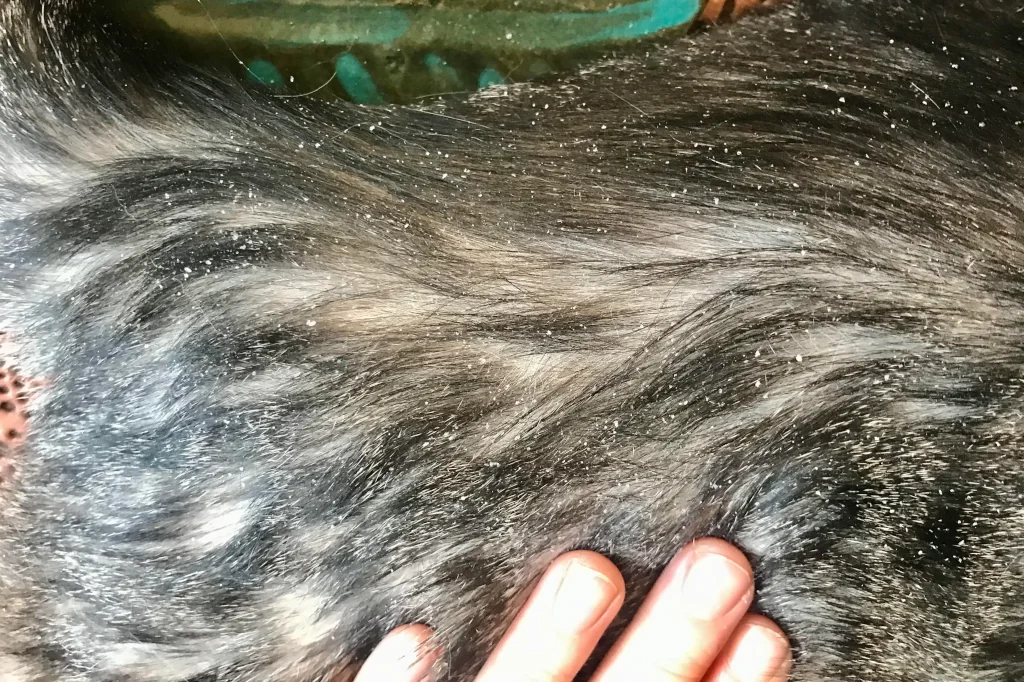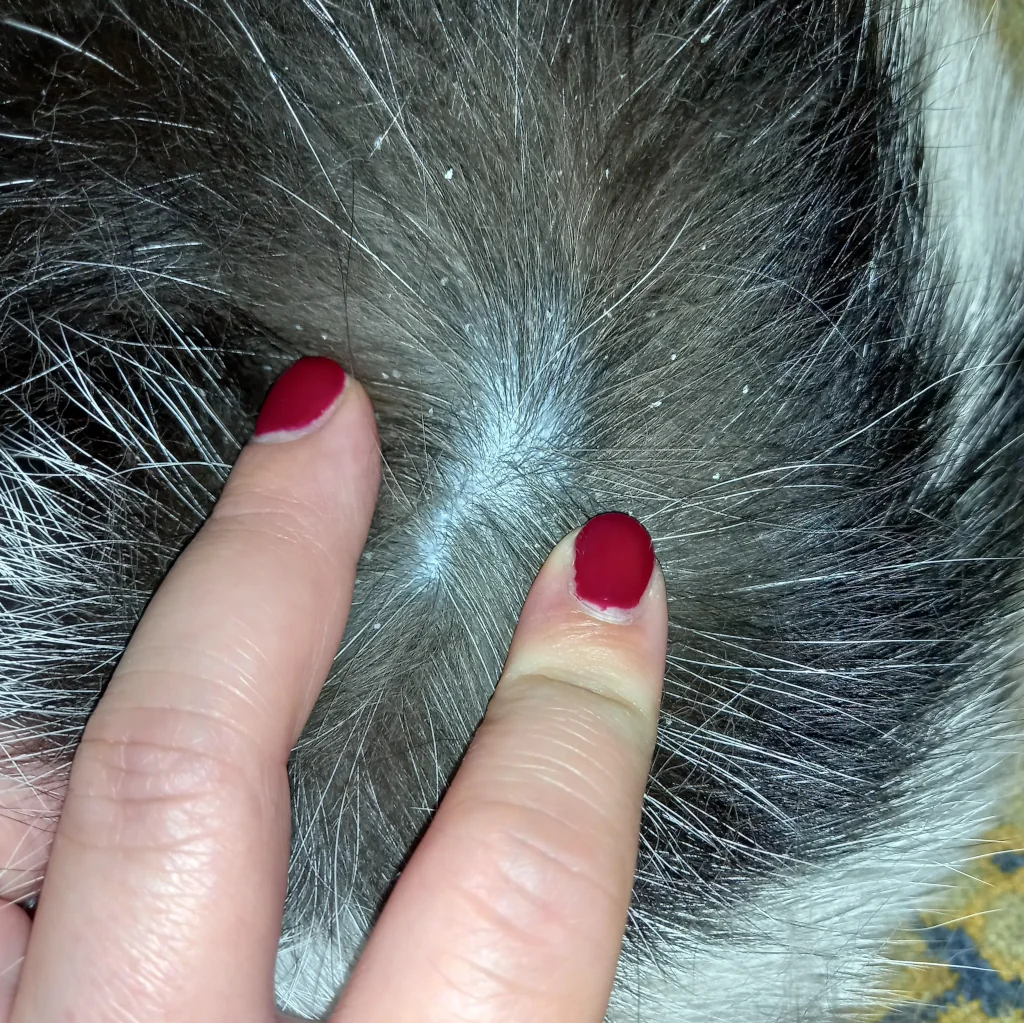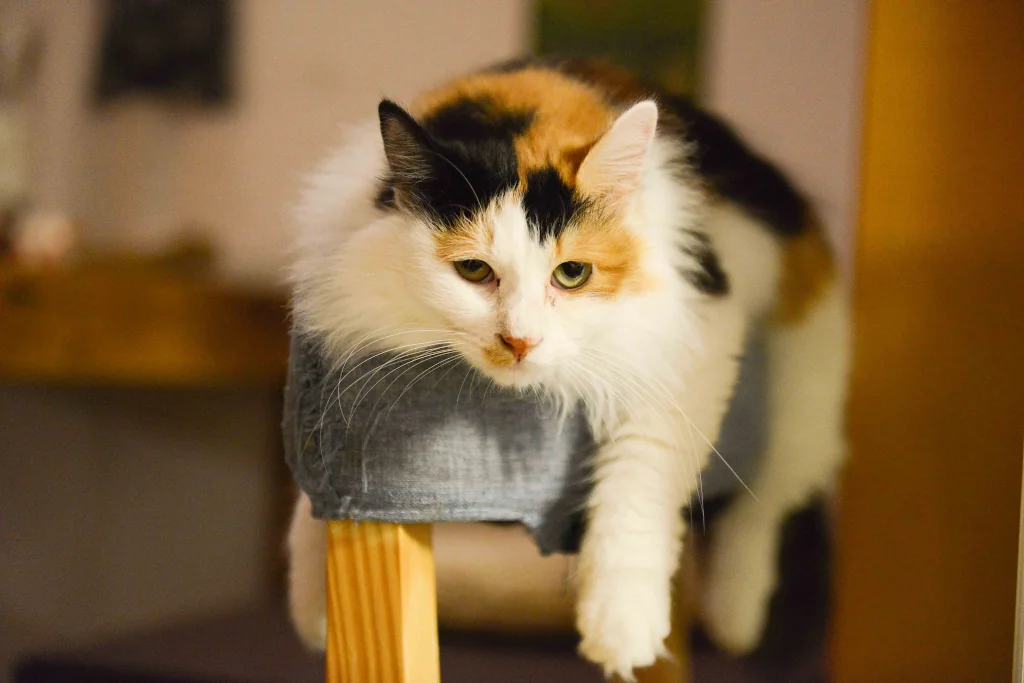Disclosure: We may earn a commission from helpful, relevant links in our content. No cost to you. See our privacy policy.
Seeing flakes on your cat’s fur can be puzzling, and more so, worrisome.
You can’t help but question if the dandruff and dry skin are just a passing phase or signs of something more serious. You start to wonder if your usual grooming routine is not enough, or worse, causing this.
We get it, and we’re here to provide insight behind those flaky patches and guide you through managing them. We invite you to travel down the feline dandruff lane with us – let’s untangle this hairy puzzle together.

Why Is Your Cat Flaky? Understanding Dandruff and Dry Skin
Cats, just like us, can suffer from dry skin and dandruff. However, a flaky coat isn’t a feline fashion statement but a hint at what’s going on beneath the fur.
Dandruff and dry skin can be caused by several factors, such as environmental conditions, inadequate grooming, and even the wrong diet.
Let’s start with your cat’s environment. Low humidity levels, common in colder months when heaters are running, can dry out your cat’s skin. Similarly, a dusty environment or allergens can irritate their skin, leading to dandruff.
Next, the grooming. Cats are self-groomers and use their tongues to distribute oils evenly across their fur. But sometimes, they need a little help from us, especially if they’re overweight or senior cats, as they might not reach certain areas, resulting in dry skin.
Finally, the diet. Cats require specific nutrients to maintain healthy skin and fur, and a lack of these nutrients can cause dry skin and dandruff. Essential fatty acids like omega-3 and omega-6 play a crucial role in keeping your cat’s skin hydrated and dandruff-free.
So if you spot flakes on your feline friend, it’s a sign that you may need to reassess their environment, grooming routine, or diet. Now, let’s check the solutions.

How Can You Treat Your Cat’s Dandruff at Home?
Managing cat dandruff at home isn’t as intimidating as it might seem. Here’s a streamlined strategy that will help you restore your cat’s healthy, shiny coat.
- Start by assessing the environment – if it’s too dry, consider using a humidifier to add moisture to the air. Likewise, ensure your cat’s resting area is dust-free, especially if your furry pal is allergic to dust mites.
- Your cat’s grooming routine is just as essential. While they are self-groomers, some cats might need a helping hand. Brushing your cat’s fur regularly can distribute the natural oils evenly across their skin, reducing dryness and dandruff. Consider using a grooming brush designed to reach the undercoat, an often neglected area that can become a breeding ground for dandruff.
- The diet is the next big area to focus on. Incorporating food rich in Omega-3 and Omega-6 fatty acids will keep your cat’s skin hydrated from within. Besides the food itself, you can even add some Omega-3s to your cats diet through supplements, such as the Nordic Naturals Omega 3.
- Don’t forget the water! Keeping a cat hydrated can sometimes be a challenge – here’s a unique tip: consider using a cat water fountain. These attract cats to drink more water, ensuring their hydration levels are up to the mark, helping to combat skin dryness.
Implementing these steps consistently will gradually ease your cat’s dandruff issue. However, remember to take it slow and allow your cat to adjust to these changes.
Suggested read: Cat Grooming Guide
Professional Treatments: When Are They Needed?
Although home remedies are excellent for managing mild to moderate cat dandruff, there may come a time when professional intervention is necessary.
Firstly, if you’ve tried all the home remedies and the dandruff problem persists, it may be time to consult a vet. Your vet can prescribe medicated shampoos or lotions tailored to your cat’s needs.
Secondly, if your cat seems excessively itchy, is losing fur, or has red, inflamed skin alongside dandruff, it could indicate an underlying health issue such as a skin infection or a parasite infestation. In such cases, immediate vet attention is essential.
Suggested reading: Cat Skin & Coat Care
Lastly, senior or overweight cats who can’t groom themselves properly might benefit from professional grooming services. They can conduct a thorough clean-up, reaching areas your cat might not be able to groom, helping to reduce dandruff.
Remember, while it’s important to tackle dandruff, the comfort and health of your cat are paramount. If your cat shows signs of stress or discomfort during any of these processes, it’s always best to consult with a vet.

The Role of Diet and Hydration in Preventing Dry Skin
Diet and hydration play a pivotal role in maintaining your cat’s skin health and preventing dandruff.
First and foremost, let’s address diet. A well-balanced, nutrient-rich diet is the cornerstone of healthy skin. Essential fatty acids, particularly Omega-3 and Omega-6, have potent skin-nourishing properties. They aid in skin barrier function and hydration, reducing dryness and flakiness.
High-quality commercial cat foods usually contain these ingredients. But, adding fish like salmon or mackerel to your cat’s diet (assuming they are not allergic) can provide an additional Omega-3 boost.
Supplementing your cat’s diet with vitamins A and E can also contribute to healthier skin. Vitamin A supports skin cell regeneration, while Vitamin E has antioxidant properties that protect skin cells from damage. Your vet can guide you on the right supplementation for your cat.
Let’s not forget hydration. Cats, by nature, have a low thirst drive. Many derive the majority of their water intake from their diet, especially if they consume wet food. However, if your cat primarily eats dry food, they might not be getting enough hydration, leading to dry skin.
A unique solution to encourage hydration in cats is a cat water fountain, such as this highly popular Veken Cat Water Fountain. The trickling sound of water mimics a natural water source, enticing cats to drink more.
Providing multiple water stations around your home can also promote better hydration.
Can Health Issues Cause Dandruff and Dry Skin in Cats?
Sometimes, dandruff and dry skin in cats are more than just a response to environmental factors – they could be a sign of underlying health issues. My friend learned this the hard way with her cat, Felix.
Felix had always had a shiny coat and clear skin. But as he got older, I noticed his coat became dull and flaky. Initially, I chalked it up to his diet or the dry winter air. My friend tried different remedies: increasing the humidity at home, introducing Omega-3 rich foods, but nothing seemed to work. Eventually, a vet visit revealed that Felix had developed diabetes, a condition that often causes skin issues in cats.
This experience taught my friend the importance of professional vet care in detecting underlying health problems. Conditions such as diabetes, hyperthyroidism, and parasitic infections can all lead to skin issues in cats. So, while home remedies can alleviate symptoms, they cannot replace the value of a professional diagnosis and treatment plan.
Always keep a close eye on your cat’s skin and coat condition, and if changes persist despite your best efforts, it’s time to consult with a vet. Remember, you know your feline friend better than anyone else – trust your instincts, but also, trust science and medicine.
FAQs
Are some cat breeds more prone to dandruff and dry skin?
While any cat can develop dry skin or dandruff, some breeds like the Sphynx, Devon Rex, and Cornish Rex, with less hair to distribute skin oils evenly, may be more susceptible to skin issues.
How often should I bathe my cat if it has dandruff or dry skin?
Generally, cats don’t need frequent baths as their self-grooming habits distribute skin oils, keeping their skin healthy. However, in cases of severe dandruff not improving with other methods, occasional, once-a-month bathing with a vet-recommended moisturizing cat shampoo may help.
Can indoor cats develop dandruff more frequently than outdoor cats?
Indoor cats may be more susceptible to dandruff due to consistent exposure to artificial heating or cooling systems which can dry out their skin. However, this can be mitigated by maintaining a balanced diet, regular grooming, and good hydration.
Does shedding season affect my cat’s dandruff or dry skin condition?
Shedding season can temporarily worsen a cat’s dandruff or dry skin condition as dead hair and skin cells are released. Regular brushing during this period can help remove these excess materials and distribute skin oils more evenly.
Alex, a passionate animal lover, has experience in training and understanding animal behavior. As a proud pet parent to two dogs and three cats, he founded AnimalReport.net to share insights from animal experts and expand his knowledge of the animal kingdom.




